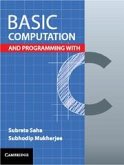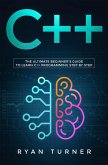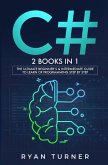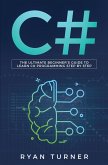Reema Thareja
Introduction to C Programming
Reema Thareja
Introduction to C Programming
- Broschiertes Buch
- Merkliste
- Auf die Merkliste
- Bewerten Bewerten
- Teilen
- Produkt teilen
- Produkterinnerung
- Produkterinnerung
The book starts with an introduction to programming in general followed by a detailed introduction to C programming. It then delves into a complete analysis of various constructs of C such as decision control and looping statements, functions, arrays, strings, pointers, structure and union, file management, and pre-processor directives. It also provides a separate chapter on linked list detailing the various kinds of linked lists and how they are used to allocate memory dynamically. A highly detailed pedagogical approach is followed throughout the book, which includes plenty of examples,…mehr
Andere Kunden interessierten sich auch für
![Bare-Metal Embedded C Programming Bare-Metal Embedded C Programming]() Israel GbatiBare-Metal Embedded C Programming39,99 €
Israel GbatiBare-Metal Embedded C Programming39,99 €![C Programming For Beginners C Programming For Beginners]() Tim WarrenC Programming For Beginners12,99 €
Tim WarrenC Programming For Beginners12,99 €![Basic Computation and Programming with C Basic Computation and Programming with C]() Subrata SahaBasic Computation and Programming with C93,99 €
Subrata SahaBasic Computation and Programming with C93,99 €![C++ C++]() Ryan TurnerC++26,99 €
Ryan TurnerC++26,99 €![Memory Thinking for C & C++ Linux Diagnostics Memory Thinking for C & C++ Linux Diagnostics]() Dmitry VostokovMemory Thinking for C & C++ Linux Diagnostics72,99 €
Dmitry VostokovMemory Thinking for C & C++ Linux Diagnostics72,99 €![C C]() Ryan TurnerC36,99 €
Ryan TurnerC36,99 €![C C]() Ryan TurnerC27,99 €
Ryan TurnerC27,99 €-
-
-
The book starts with an introduction to programming in general followed by a detailed introduction to C programming. It then delves into a complete analysis of various constructs of C such as decision control and looping statements, functions, arrays, strings, pointers, structure and union, file management, and pre-processor directives. It also provides a separate chapter on linked list detailing the various kinds of linked lists and how they are used to allocate memory dynamically. A highly detailed pedagogical approach is followed throughout the book, which includes plenty of examples, figures, programming tips, keywords, and end-chapter exercises. These features should render the book an ideal resource for students to master and fine-tune the art of writing C programs.
Produktdetails
- Produktdetails
- Verlag: Oxford University Press, USA
- 2nd UK edition
- Seitenzahl: 394
- Erscheinungstermin: 1. November 2014
- Englisch
- Abmessung: 216mm x 274mm x 18mm
- Gewicht: 762g
- ISBN-13: 9780199452057
- ISBN-10: 0199452059
- Artikelnr.: 42759886
- Herstellerkennzeichnung
- Libri GmbH
- Europaallee 1
- 36244 Bad Hersfeld
- gpsr@libri.de
- Verlag: Oxford University Press, USA
- 2nd UK edition
- Seitenzahl: 394
- Erscheinungstermin: 1. November 2014
- Englisch
- Abmessung: 216mm x 274mm x 18mm
- Gewicht: 762g
- ISBN-13: 9780199452057
- ISBN-10: 0199452059
- Artikelnr.: 42759886
- Herstellerkennzeichnung
- Libri GmbH
- Europaallee 1
- 36244 Bad Hersfeld
- gpsr@libri.de
Reema Thareja is Assistant Professor at the Department of Computer Science, Shyama Prasad Mukherjee College for Women, Univesity of Delhi. She has completed MCA (Software Engineering) and MPhil (Computer Science). She specializes in programming languages, OS, DBMS, multimedia, and web technologies and is currently pursuing research in the area of improving data warehouse quality.
1: Introduction to Programming
1.1 Introduction to Computer Software
1.2 Classification of Computer Software
1.3 Programming Languages
1.4 Generation of Programming Languages
1.5 Categorization of High Level Languages
2: Introduction to C
2.1 Introduction
2.2 Structure of a C Program
2.3 Writing the First C Program?
2.4 Files Used in a C Program
2.5 Compiling and Executing C Programs
2.6 Using Comments
2.7 Keywords
2.8 Identifiers
2.9 Basic Data Types in C
2.10 Variables
2.11 Constants
2.12 Input/output Statement in C
2.13 Operators in C
2.14 Programming Examples
2.15 Type Conversion and Typecasting
Annexure
3: Decision Control and Looping Statements
3.1 Introduction to Decision Control Statements
3.2 Conditional Branching Statements
3.3 Iterative Statements
3.4 Nested Loops
3.5 The Break and Continue Statement
3.6 Goto Statement
3.7 Building a Robust C Program
Annexure 2?
4: Functions
4.1 Introduction
4.2 Using Functions
4.3 Function Declaration/Function Prototype
4.4 Function Definition
4.5 Function Call
4.6 Return Statement
4.7 Passing Parameters to the Function
4.8 Scope of Variables
4.9 Storage Classes
4.10 Recursive Functions
4.11 Types of Recursion
4.12 Tower of Hanoi
4.13 Recursion versus Iteration
Annexure 3
5: Arrays
5.1 Introduction
5.2 Declaration of Arrays
5.3 Accessing Array Elements
5.4 Storing Values in Arrays
5.5 Length of an Array
5.6 Array Operations
5.7 One-Dimensional Arrays for Inter-Function Communication
5.8 Two-Dimensional Arrays
5.9 Operations on Two-dimensional(2D) Arrays
5.10 Two-Dimensional Arrays for Inter-Function Communication
5.11 Multidimensional Arrays
5.12 Sparse Matrices
Annexure 4
6: Strings
6.1 Introduction
6.2 Suppressing Input
6.3 String Taxonomy
6.4 String Operations
6.5 Miscellaneous String and Character Functions
6.6 Array of Strings?213
7: Pointers
7.1 Understanding the Computer's Memory
7.2 Introduction to Pointers
7.3 Declaring Pointer Variables
7.4 Pointer Expressions and Pointer Arithmetic
7.5 Null Pointers
7.6 Generic Pointers
7.7 Passing Arguments to Function Using Pointers
7.8 Pointers and Arrays
7.9 Passing an Array to a Function
7.10 Difference between Array Name and Pointer
7.11 Pointers and Strings
7.12 Array of Pointers
7.13 Pointers and 2-D Arrays
7.14 Pointers and 3-D Array
7.15 Function Pointers
7.16 Array of Function Pointers
7.17 Pointers to Pointers
7.18 Memory Allocation in C Programs
7.19 Memory Usage
7.20 Dynamic Memory Allocation
7.21 Drawback of Pointers
Annexure 5
8: Structure, Union, and Enumerated Data Types
8.1 Introduction
8.2 Nested Structures
8.3 Arrays of Structures
8.4 Structures and Functions
8.5 Self-referential Structures
8.6 Union?
8.7 Arrays of Union Variables
8.8 Unions Inside Structures
8.9 Enumerated Data Types
Annexure 6
9: Files
9.1 Introduction to Files
9.2 Using Files in C
9.3 Read Data from Files
9.4 Writing Data to Files
9.5 Detecting the End-of-File
9.6 Error Handling During File Operations
9.7 Accepting Command Line Arguments
9.8 Functions for Selecting a Record Randomly
9.9 remove ()?
9.10 Renaming the File
9.11 Creating a Temporary File
10: Preprocessor Directives
10.1 Introduction
10.2 Types of Preprocessor Directives
10.3 #define
10.4 #include
10.5 #undef
10.6 #line
10.7 Pragma Directives
10.8 Conditional Directives
10.9 The Defined Operator
10.10 #error Directive
10.11 Predefined Macro Names
Annexure
11: Linked Lists
11.1 Introduction
11.2 Linked Lists versus Arrays
11.3 Memory Allocation and Deallocation for a Linked List
11.4 Different Types of Linked Lists
11.5 Singly Linked List
11.6 Circular Linked List
11.7 Doubly Linked List?
11.8 Circular Doubly Linked List
11.9 Header Linked List
1.1 Introduction to Computer Software
1.2 Classification of Computer Software
1.3 Programming Languages
1.4 Generation of Programming Languages
1.5 Categorization of High Level Languages
2: Introduction to C
2.1 Introduction
2.2 Structure of a C Program
2.3 Writing the First C Program?
2.4 Files Used in a C Program
2.5 Compiling and Executing C Programs
2.6 Using Comments
2.7 Keywords
2.8 Identifiers
2.9 Basic Data Types in C
2.10 Variables
2.11 Constants
2.12 Input/output Statement in C
2.13 Operators in C
2.14 Programming Examples
2.15 Type Conversion and Typecasting
Annexure
3: Decision Control and Looping Statements
3.1 Introduction to Decision Control Statements
3.2 Conditional Branching Statements
3.3 Iterative Statements
3.4 Nested Loops
3.5 The Break and Continue Statement
3.6 Goto Statement
3.7 Building a Robust C Program
Annexure 2?
4: Functions
4.1 Introduction
4.2 Using Functions
4.3 Function Declaration/Function Prototype
4.4 Function Definition
4.5 Function Call
4.6 Return Statement
4.7 Passing Parameters to the Function
4.8 Scope of Variables
4.9 Storage Classes
4.10 Recursive Functions
4.11 Types of Recursion
4.12 Tower of Hanoi
4.13 Recursion versus Iteration
Annexure 3
5: Arrays
5.1 Introduction
5.2 Declaration of Arrays
5.3 Accessing Array Elements
5.4 Storing Values in Arrays
5.5 Length of an Array
5.6 Array Operations
5.7 One-Dimensional Arrays for Inter-Function Communication
5.8 Two-Dimensional Arrays
5.9 Operations on Two-dimensional(2D) Arrays
5.10 Two-Dimensional Arrays for Inter-Function Communication
5.11 Multidimensional Arrays
5.12 Sparse Matrices
Annexure 4
6: Strings
6.1 Introduction
6.2 Suppressing Input
6.3 String Taxonomy
6.4 String Operations
6.5 Miscellaneous String and Character Functions
6.6 Array of Strings?213
7: Pointers
7.1 Understanding the Computer's Memory
7.2 Introduction to Pointers
7.3 Declaring Pointer Variables
7.4 Pointer Expressions and Pointer Arithmetic
7.5 Null Pointers
7.6 Generic Pointers
7.7 Passing Arguments to Function Using Pointers
7.8 Pointers and Arrays
7.9 Passing an Array to a Function
7.10 Difference between Array Name and Pointer
7.11 Pointers and Strings
7.12 Array of Pointers
7.13 Pointers and 2-D Arrays
7.14 Pointers and 3-D Array
7.15 Function Pointers
7.16 Array of Function Pointers
7.17 Pointers to Pointers
7.18 Memory Allocation in C Programs
7.19 Memory Usage
7.20 Dynamic Memory Allocation
7.21 Drawback of Pointers
Annexure 5
8: Structure, Union, and Enumerated Data Types
8.1 Introduction
8.2 Nested Structures
8.3 Arrays of Structures
8.4 Structures and Functions
8.5 Self-referential Structures
8.6 Union?
8.7 Arrays of Union Variables
8.8 Unions Inside Structures
8.9 Enumerated Data Types
Annexure 6
9: Files
9.1 Introduction to Files
9.2 Using Files in C
9.3 Read Data from Files
9.4 Writing Data to Files
9.5 Detecting the End-of-File
9.6 Error Handling During File Operations
9.7 Accepting Command Line Arguments
9.8 Functions for Selecting a Record Randomly
9.9 remove ()?
9.10 Renaming the File
9.11 Creating a Temporary File
10: Preprocessor Directives
10.1 Introduction
10.2 Types of Preprocessor Directives
10.3 #define
10.4 #include
10.5 #undef
10.6 #line
10.7 Pragma Directives
10.8 Conditional Directives
10.9 The Defined Operator
10.10 #error Directive
10.11 Predefined Macro Names
Annexure
11: Linked Lists
11.1 Introduction
11.2 Linked Lists versus Arrays
11.3 Memory Allocation and Deallocation for a Linked List
11.4 Different Types of Linked Lists
11.5 Singly Linked List
11.6 Circular Linked List
11.7 Doubly Linked List?
11.8 Circular Doubly Linked List
11.9 Header Linked List
1: Introduction to Programming
1.1 Introduction to Computer Software
1.2 Classification of Computer Software
1.3 Programming Languages
1.4 Generation of Programming Languages
1.5 Categorization of High Level Languages
2: Introduction to C
2.1 Introduction
2.2 Structure of a C Program
2.3 Writing the First C Program?
2.4 Files Used in a C Program
2.5 Compiling and Executing C Programs
2.6 Using Comments
2.7 Keywords
2.8 Identifiers
2.9 Basic Data Types in C
2.10 Variables
2.11 Constants
2.12 Input/output Statement in C
2.13 Operators in C
2.14 Programming Examples
2.15 Type Conversion and Typecasting
Annexure
3: Decision Control and Looping Statements
3.1 Introduction to Decision Control Statements
3.2 Conditional Branching Statements
3.3 Iterative Statements
3.4 Nested Loops
3.5 The Break and Continue Statement
3.6 Goto Statement
3.7 Building a Robust C Program
Annexure 2?
4: Functions
4.1 Introduction
4.2 Using Functions
4.3 Function Declaration/Function Prototype
4.4 Function Definition
4.5 Function Call
4.6 Return Statement
4.7 Passing Parameters to the Function
4.8 Scope of Variables
4.9 Storage Classes
4.10 Recursive Functions
4.11 Types of Recursion
4.12 Tower of Hanoi
4.13 Recursion versus Iteration
Annexure 3
5: Arrays
5.1 Introduction
5.2 Declaration of Arrays
5.3 Accessing Array Elements
5.4 Storing Values in Arrays
5.5 Length of an Array
5.6 Array Operations
5.7 One-Dimensional Arrays for Inter-Function Communication
5.8 Two-Dimensional Arrays
5.9 Operations on Two-dimensional(2D) Arrays
5.10 Two-Dimensional Arrays for Inter-Function Communication
5.11 Multidimensional Arrays
5.12 Sparse Matrices
Annexure 4
6: Strings
6.1 Introduction
6.2 Suppressing Input
6.3 String Taxonomy
6.4 String Operations
6.5 Miscellaneous String and Character Functions
6.6 Array of Strings?213
7: Pointers
7.1 Understanding the Computer's Memory
7.2 Introduction to Pointers
7.3 Declaring Pointer Variables
7.4 Pointer Expressions and Pointer Arithmetic
7.5 Null Pointers
7.6 Generic Pointers
7.7 Passing Arguments to Function Using Pointers
7.8 Pointers and Arrays
7.9 Passing an Array to a Function
7.10 Difference between Array Name and Pointer
7.11 Pointers and Strings
7.12 Array of Pointers
7.13 Pointers and 2-D Arrays
7.14 Pointers and 3-D Array
7.15 Function Pointers
7.16 Array of Function Pointers
7.17 Pointers to Pointers
7.18 Memory Allocation in C Programs
7.19 Memory Usage
7.20 Dynamic Memory Allocation
7.21 Drawback of Pointers
Annexure 5
8: Structure, Union, and Enumerated Data Types
8.1 Introduction
8.2 Nested Structures
8.3 Arrays of Structures
8.4 Structures and Functions
8.5 Self-referential Structures
8.6 Union?
8.7 Arrays of Union Variables
8.8 Unions Inside Structures
8.9 Enumerated Data Types
Annexure 6
9: Files
9.1 Introduction to Files
9.2 Using Files in C
9.3 Read Data from Files
9.4 Writing Data to Files
9.5 Detecting the End-of-File
9.6 Error Handling During File Operations
9.7 Accepting Command Line Arguments
9.8 Functions for Selecting a Record Randomly
9.9 remove ()?
9.10 Renaming the File
9.11 Creating a Temporary File
10: Preprocessor Directives
10.1 Introduction
10.2 Types of Preprocessor Directives
10.3 #define
10.4 #include
10.5 #undef
10.6 #line
10.7 Pragma Directives
10.8 Conditional Directives
10.9 The Defined Operator
10.10 #error Directive
10.11 Predefined Macro Names
Annexure
11: Linked Lists
11.1 Introduction
11.2 Linked Lists versus Arrays
11.3 Memory Allocation and Deallocation for a Linked List
11.4 Different Types of Linked Lists
11.5 Singly Linked List
11.6 Circular Linked List
11.7 Doubly Linked List?
11.8 Circular Doubly Linked List
11.9 Header Linked List
1.1 Introduction to Computer Software
1.2 Classification of Computer Software
1.3 Programming Languages
1.4 Generation of Programming Languages
1.5 Categorization of High Level Languages
2: Introduction to C
2.1 Introduction
2.2 Structure of a C Program
2.3 Writing the First C Program?
2.4 Files Used in a C Program
2.5 Compiling and Executing C Programs
2.6 Using Comments
2.7 Keywords
2.8 Identifiers
2.9 Basic Data Types in C
2.10 Variables
2.11 Constants
2.12 Input/output Statement in C
2.13 Operators in C
2.14 Programming Examples
2.15 Type Conversion and Typecasting
Annexure
3: Decision Control and Looping Statements
3.1 Introduction to Decision Control Statements
3.2 Conditional Branching Statements
3.3 Iterative Statements
3.4 Nested Loops
3.5 The Break and Continue Statement
3.6 Goto Statement
3.7 Building a Robust C Program
Annexure 2?
4: Functions
4.1 Introduction
4.2 Using Functions
4.3 Function Declaration/Function Prototype
4.4 Function Definition
4.5 Function Call
4.6 Return Statement
4.7 Passing Parameters to the Function
4.8 Scope of Variables
4.9 Storage Classes
4.10 Recursive Functions
4.11 Types of Recursion
4.12 Tower of Hanoi
4.13 Recursion versus Iteration
Annexure 3
5: Arrays
5.1 Introduction
5.2 Declaration of Arrays
5.3 Accessing Array Elements
5.4 Storing Values in Arrays
5.5 Length of an Array
5.6 Array Operations
5.7 One-Dimensional Arrays for Inter-Function Communication
5.8 Two-Dimensional Arrays
5.9 Operations on Two-dimensional(2D) Arrays
5.10 Two-Dimensional Arrays for Inter-Function Communication
5.11 Multidimensional Arrays
5.12 Sparse Matrices
Annexure 4
6: Strings
6.1 Introduction
6.2 Suppressing Input
6.3 String Taxonomy
6.4 String Operations
6.5 Miscellaneous String and Character Functions
6.6 Array of Strings?213
7: Pointers
7.1 Understanding the Computer's Memory
7.2 Introduction to Pointers
7.3 Declaring Pointer Variables
7.4 Pointer Expressions and Pointer Arithmetic
7.5 Null Pointers
7.6 Generic Pointers
7.7 Passing Arguments to Function Using Pointers
7.8 Pointers and Arrays
7.9 Passing an Array to a Function
7.10 Difference between Array Name and Pointer
7.11 Pointers and Strings
7.12 Array of Pointers
7.13 Pointers and 2-D Arrays
7.14 Pointers and 3-D Array
7.15 Function Pointers
7.16 Array of Function Pointers
7.17 Pointers to Pointers
7.18 Memory Allocation in C Programs
7.19 Memory Usage
7.20 Dynamic Memory Allocation
7.21 Drawback of Pointers
Annexure 5
8: Structure, Union, and Enumerated Data Types
8.1 Introduction
8.2 Nested Structures
8.3 Arrays of Structures
8.4 Structures and Functions
8.5 Self-referential Structures
8.6 Union?
8.7 Arrays of Union Variables
8.8 Unions Inside Structures
8.9 Enumerated Data Types
Annexure 6
9: Files
9.1 Introduction to Files
9.2 Using Files in C
9.3 Read Data from Files
9.4 Writing Data to Files
9.5 Detecting the End-of-File
9.6 Error Handling During File Operations
9.7 Accepting Command Line Arguments
9.8 Functions for Selecting a Record Randomly
9.9 remove ()?
9.10 Renaming the File
9.11 Creating a Temporary File
10: Preprocessor Directives
10.1 Introduction
10.2 Types of Preprocessor Directives
10.3 #define
10.4 #include
10.5 #undef
10.6 #line
10.7 Pragma Directives
10.8 Conditional Directives
10.9 The Defined Operator
10.10 #error Directive
10.11 Predefined Macro Names
Annexure
11: Linked Lists
11.1 Introduction
11.2 Linked Lists versus Arrays
11.3 Memory Allocation and Deallocation for a Linked List
11.4 Different Types of Linked Lists
11.5 Singly Linked List
11.6 Circular Linked List
11.7 Doubly Linked List?
11.8 Circular Doubly Linked List
11.9 Header Linked List








